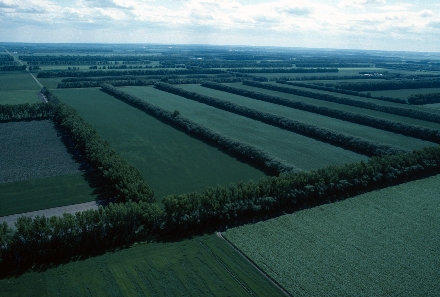Soil Science Society of America
5585 Guilford Road • Madison, WI 53711-5801 • 608-273-8080 • Fax 608-273-2021
www.soils.org
Twitter | Facebook | Soils Matter Blog
NEWS RELEASE
Contact: Hanna Jeske, Associate Director of Marketing and Brand Strategy, 608-268-3972, hjeske@sciencesocieties.org
Assessing Agroforestry's Advantages
MADISON, WI, JUNE 30, 2011 -- Agroforestry, the deliberate placement of trees into crop and livestock operations, can help capture substantial amounts of carbon on agricultural lands while providing production and conservation benefits. However, we currently lack tools for accurately estimating current and projected carbon values in these systems.
In North America, windbreaks are an effective carbon-capturing option. Only occupying about 2 to 5% of the land, windbreaks also help protect crops and livestock, as well as reduce wind erosion. They provide a means to increase production while reducing greenhouse gases.

James Brandle, a University of Nebraska–Lincoln professor, explains that unlike forests, the linear design of windbreaks creates a more open environment with different light and climate conditions. As a result, agroforestry trees usually have different characteristics than trees grown under forest conditions. New tools specifically designed for windbreak trees are needed to determine current or future amounts of carbon contained in agroforestry practices.
Researchers at the University of Florida, University of Kansas, University of Nebraska and the USDA National Agroforestry Center (NAC) have developed a model to predict the amount of carbon contained by agroforestry systems. This modeling approach uses detailed web-available data for windbreak, soils and climate.
While this research focused only on green ash windbreak growth in Nebraska, it provides a good basis for determining agroforestry’s contributions in farming operations.
This research was supported by the Research Joint Venture Agreement through the USFS Rocky Mountain Research Station, Forest Service, and the McIntyre-Stennis Forestry Research Program at the University of Nebraska. The complete results from this study were published in the May/June 2011 issue of the Journal of Environmental Quality.
Photo Caption: North Dakota field windbreaks protect adjacent field crops, reduce wind erosion and store carbon. A typical, 2-row, mixed species field windbreak will store between 15 and 30 metric tons of carbon per mile. (Photo courtesy of USDA-NRCS)
###
Journal of Environmental Quality publishes original research, reviews and analyses, and environmental issue articles that address anthropogenic impacts on water, soil, and the atmosphere and pertain to some aspect of environmental quality in natural and agricultural ecosystems.